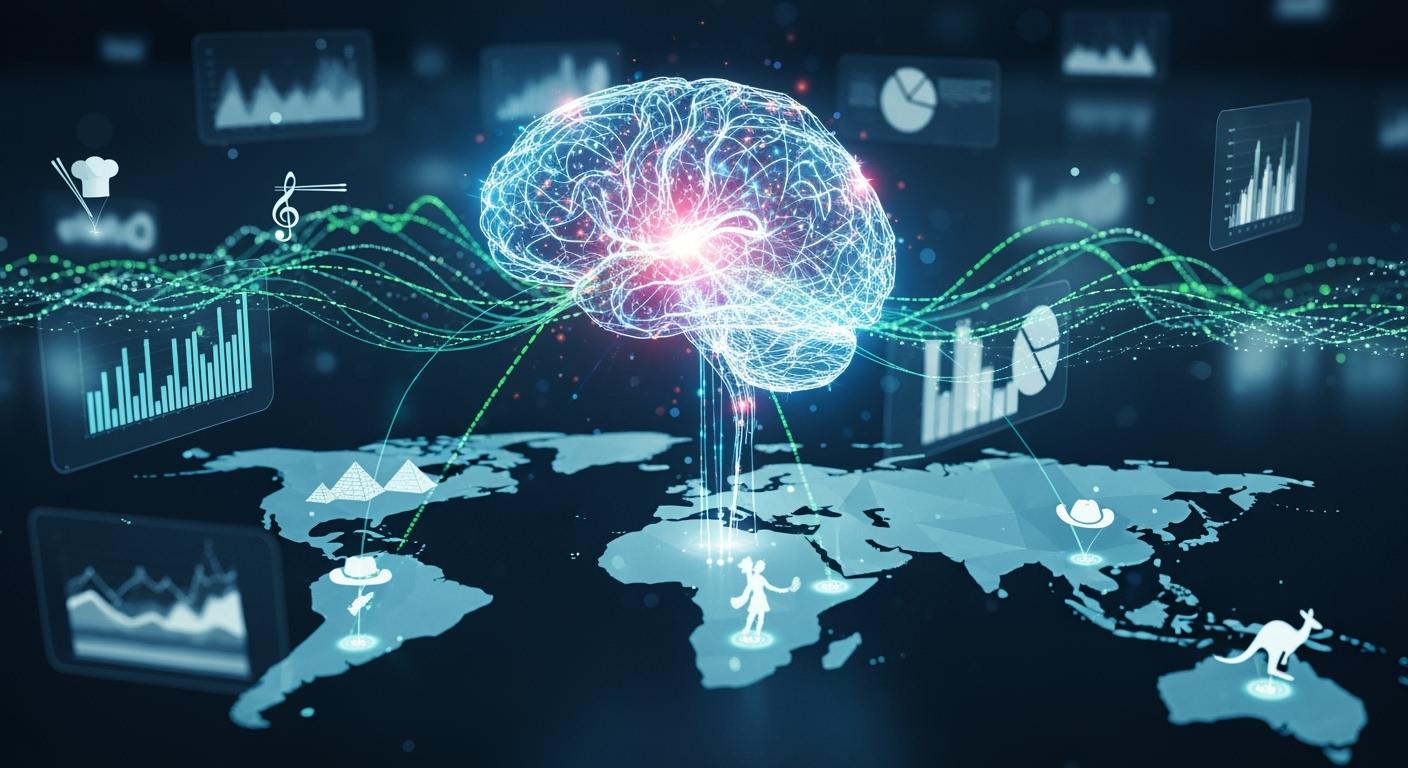
Yes, AI can uncover authentic regional preferences. This capability moves market analysis beyond broad stereotypes. This powerful AI provides deep market insights into any regional market.
The core AI mechanism synthesizes diverse data. This regional data includes sales data, social media data, and local event calendars.
Advanced AI models analyze this complex data. The AI finds contextual patterns revealing true regional consumer preferences. Traditional market research often misses these local preferences. This is how AI to identify regional tastes provides a clearer picture for any market.
How AI Decodes Regional Wants

AI offers a deeper understanding of a local market. It moves beyond basic demographics to uncover the cultural identity driving consumer behavior. This technology helps businesses understand what a regional customer truly wants.
Beyond Demographics to Local Identity
Traditional market research often stops at demographics like age and income. AI goes further. It analyzes language, sentiment, and cultural context to build a complete picture of regional preferences. For example, AI can monitor social media conversations for emotion-based hashtags. Mercedes-Benz used this method to track audience sentiment in Poland, adjusting its campaign to match the local mood. This ai-driven analytics approach helps brands connect with customer feelings. During the pandemic, Chipotle used AI to analyze customer sentiment on social media. This data provided insights that shaped its marketing and safety strategies, showing a deep understanding of consumer concerns. The AI deciphers the unique values and shared experiences that define a regional community.
The AI Toolkit for Analysis
AI uses a powerful set of tools to process vast amounts of data. These tools provide speed and accuracy that traditional methods cannot match.
| Aspect | Traditional Methods | AI Analysis |
|---|---|---|
| Speed | Slower process | Up to 100 times faster |
| Accuracy | Prone to human bias | Eliminates bias, improves accuracy |
| Data Processing | Limited with unstructured data | Uncovers deep insights from text and images |
Key technologies in this toolkit include:
- Natural Language Processing (NLP): This AI technology analyzes text from reviews and social media. It understands context, slang, and sentiment. This helps businesses gauge public opinion and identify emerging trends.
- Predictive Analytics: This tool forecasts future consumer behavior. Retailers use predictive analytics to stock products based on weather forecasts. For instance, predictive analytics can signal a store to order more raincoats before a storm. This use of predictive analytics helps manage inventory effectively. Companies also use predictive analytics to anticipate market trends and meet customer demand proactively. This is how ai to identify regional consumer preferences gives businesses a competitive edge.
Using AI to Identify Local Tastes in Action

Theoretical discussions are useful. Concrete examples show the true power of AI. Businesses across industries now use this technology to understand and meet hyper-local market demands. The results are impressive. They show significant gains in customer engagement and revenue.
Pinpointing Hyperlocal Food Preferences
The food and beverage industry offers a clear look at AI's impact. AI helps restaurants and brands move beyond generic menus. They can now cater to the specific dining preferences of a neighborhood. This technology analyzes data to find what a local customer truly wants.
AI can connect menu promotions to community events. For example, Buffalo Wild Wings in Scranton uses AI to create dynamic videos. These videos feature local high school football championships. This promotes their game-day specials to a highly relevant audience. The AI even incorporates local team logos, creating a personal connection with the customer. This strategy turns a general promotion into a community-centric event.
Global brands also use AI to act local. Coca-Cola’s "Share a Coke" campaign used AI to customize names on bottles for different regional markets. Its "Taste the Feeling" campaign created multiple ad versions with local imagery. The AI analyzed consumer responses in real-time. This allowed Coca-Cola to fine-tune its message based on local feedback. This shows how ai to identify regional consumer preferences works at a massive scale.
AI achieves this by analyzing diverse data sources.
- Internal Data: Sales trends and inventory levels show what is already popular.
- External Factors: Weather patterns and local events help predict short-term demand.
- Digital Signals: Social media sentiment and online reviews reveal emerging dining trends.
By processing this data, AI gives businesses powerful insights. It can identify neighborhoods with more health-conscious residents for a new vegan restaurant. It sifts through Yelp reviews to find common praises or complaints about dining experiences. This helps a business tailor its offerings to meet hyperlocal preferences. The return on investment is clear. Companies using AI have seen dramatic improvements.
| Metric | Before AI | After AI | Improvement |
|---|---|---|---|
| Return on Ad Spend | 1.8:1 | 4.2:1 | 133% increase |
| Customer Acquisition Cost | £37 | £18 | 51.35% decrease |
| Online Order Percentage | 15% | 38% | 153.33% increase |
| Profit Margin | 8% | 14% | 75% increase |
These numbers show that understanding local dining preferences directly boosts performance.
Mapping Regional Micro-trends in Fashion
The fashion world is also experiencing an AI revolution. Brands are using a technique called geo-fashion mapping. Geo-fashion mapping analyzes data to reveal how local culture and climate shape fashion choices in specific cities. This allows companies to move beyond one-size-fits-all collections.
Climate is a major factor in fashion. AI systems use hyper-local weather monitoring for geo-fashion mapping. They analyze temperature, humidity, and wind patterns. This data helps provide precise styling guidance. For example, AI can suggest breathable fabrics for a humid day in Miami. It might recommend layering options for a day with fluctuating temperatures in San Francisco. This level of detail helps a fashion brand serve its customer better. Geo-fashion mapping makes fashion personal and practical.
Global brands are adopting a 'chameleon' approach. They blend a broad strategy with local flavor. McDonald’s adjusts menus, and Nike features local athletes. This strategy relies on hyper-local data, cultural nuance, and smart AI-driven insights.
AI also decodes regional micro-trends by analyzing visual data. Fashion brands like Zara and Tommy Hilfiger use AI to scan millions of images. The AI looks at Instagram posts from local influencers and street style photos. It identifies emerging regional micro-trends in colors, patterns, and silhouettes. This is geo-fashion mapping in action. It can spot a unique way a scarf is styled in a specific city long before it becomes a mainstream trend. This allows brands to quickly respond to new fashion preferences. Geo-fashion mapping helps brands understand the unique fashion culture of a place.
This process of geo-fashion mapping gives brands a competitive edge. It helps them create products that resonate with a specific regional consumer. The AI can detect subtle regional micro-trends that human analysts might miss. Geo-fashion mapping turns raw data into actionable fashion insights. By understanding regional micro-trends, brands can build a stronger connection with their customer base. Geo-fashion mapping is key to unlocking local fashion preferences. The future of fashion is not just global; it is a network of regional styles understood through geo-fashion mapping and AI. This is how geo-fashion mapping identifies regional micro-trends.
Navigating AI's Challenges and Biases
While AI offers powerful tools, businesses must navigate its challenges carefully. The quality of AI insights depends entirely on the quality of the data it uses. Flawed data can lead to significant errors, creating more problems than it solves. A responsible approach is essential for any business using AI to understand its customer base.
The Risk of Data Bias and Digital Divides
AI systems learn from the data they are given. If the training data contains biases, the AI will learn and even amplify them. This creates a serious risk of reinforcing harmful stereotypes.
- Some AI models associate jobs like "engineer" with men, ignoring women in the field.
- Other AI tools have shown bias against certain names in resume screening.
- This happens because the historical data reflects past inequalities.
This problem gets worse because of the digital divide. AI often analyzes data from online sources. This process can exclude older adults or people in rural areas who are less active online. Relying on this incomplete data gives a skewed view of regional preferences. A business might misunderstand an entire customer segment, leading to poor decisions. The AI needs complete and fair data to work correctly.
Note: The famous 1936 Literary Digest poll incorrectly predicted a presidential election because its data overrepresented wealthier people. This historical mistake shows how biased data leads to wrong conclusions.
Avoiding Cultural Misinterpretation
AI also struggles to understand local culture and context. It can easily misinterpret slang, humor, or subtle social cues. This can lead to marketing messages that feel strange or offensive to a local customer. An AI might not understand that a word has a different meaning in a specific regional dialect.
The best solution is to combine AI with human expertise.
- Use Diverse Data: Train the AI with data from many different cultural backgrounds.
- Involve Human Experts: Have local cultural advisors review AI outputs. These experts can catch nuances the AI misses.
- Create Feedback Loops: Continuously update the AI with feedback from local teams. This helps the AI adapt to changing cultural trends.
This "human-in-the-loop" model ensures that a brand communicates respectfully and effectively. It allows a business to build genuine trust with each customer. This careful approach helps the AI accurately interpret data and understand true local preferences.
AI is a uniquely powerful tool. The AI helps to identify true regional preferences with unmatched speed. Its accuracy hinges on thoughtful implementation with high-quality data and human oversight for the best regional insights. This AI helps to identify regional consumer preferences. The future of AI personalization is clear. It moves businesses from generic marketing to creating authentic local and regional connections. This deep personalization builds customer loyalty and boosts customer satisfaction for every customer. The AI uses data for better personalization. This personalization creates a better personalized experience for each customer. Better personalization improves customer satisfaction. Stronger personalization builds customer loyalty. This personalization increases customer satisfaction. This personalization uses data to understand the customer. This personalization uses data to connect with the customer and their regional preferences.
FAQ
How does AI find regional preferences?
AI analyzes diverse datasets like sales figures and social media posts. It identifies deep patterns within this information. These patterns reveal authentic local tastes that traditional research often misses. This process provides a clear view of community preferences.
What data does AI use for this analysis?
AI synthesizes information from multiple sources. Key data types include:
- Sales figures and inventory levels
- Social media conversations and online reviews
- Local event calendars and weather forecasts
- Demographic and cultural information
What is the biggest risk of using AI?
The primary risk is data bias. An AI system learns from the data it receives. If the data is incomplete or reflects old stereotypes, the AI will produce biased and inaccurate insights. This can lead to poor business decisions.
Can small businesses use this AI technology?
Yes, this technology is increasingly accessible. Many platforms now offer affordable, user-friendly AI tools. Small businesses can leverage these services to gain powerful local market insights without needing a large budget or a dedicated data science team. 🧑💻
See Also
Do Your AI Tools Analyze Social Media for Business Insights?
Leveraging Data Analytics for Optimal Product Assortment Decisions and Growth
AI's Role in Managing Viral Trends Within the Fast Fashion Industry
Predicting Future Demand: AI and Data Strategies for 2025
AI Routing Algorithms Significantly Reduce Fashion Delivery Times by 22 Percent